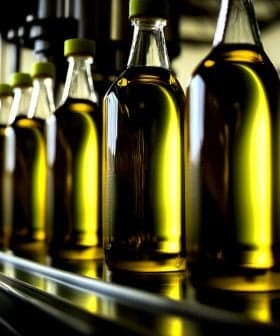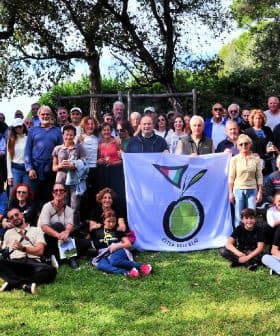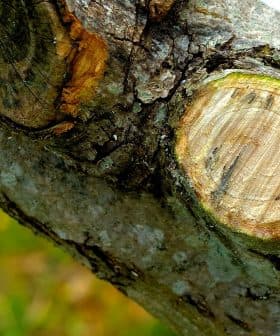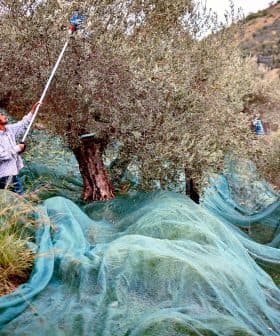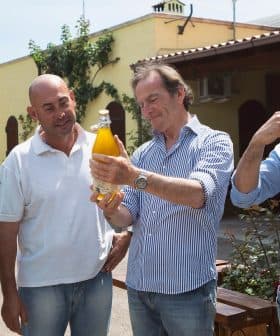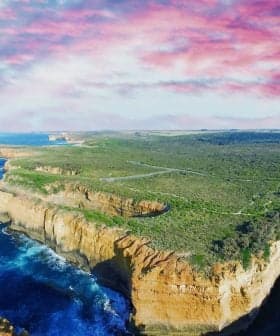Growers in Xylella-Ravaged Puglia Assess a Delicate Harvest
Farmers who have followed the phytosanitary protocol are harvesting olives from trees where the infection has been brought under control.
 Photo: Donato Minosi Olives
Photo: Donato Minosi Olives Despite the devastating impact of Xylella fastidiosa on olive groves in Puglia, some growers are experiencing a successful harvest, with healthy trees producing high-quality olives. By implementing good farming practices and organic phytosanitary measures, these growers are seeing their olive trees recover and become productive again, offering hope for the future of the region’s olive industry.
Growers in the southern Italian region of Puglia are experiencing a good olive harvest in some of the areas most severely affected by Xylella fastidiosa.
Groves full of green and healthy trees are visible among the many desiccated olive trees dotting the landscape.
If Xylella fastidiosa has infected only 50 to 60 percent of the tree, then there is a high chance to save it and bring it back to health and production.
A few kilometers away from a Salento, one of the areas most severely affected by the olive tree-killing bacteria, Paolo Marangi and his workers have been harvesting olives for more than a month in Taranto.
“We are very happy with the harvest, olive oil quality is very high, and I had not seen our olive trees so full of fruits in a long time,” he told Olive Oil Times.
See Also:Reimagining the Xylella-Devastated Landscape of Southern PugliaWhile many producers in the region are expecting a poor harvest compared to previous years, those experiencing higher yields are also set to benefit from high olive prices.
Marangi and some of his colleagues told Olive Oil Times that their olive groves are almost fully recovered nearly 10 years after Xylella fastidiosa started spreading in southern Italy.
The farmers attributed good farming practices and well-established organic phytosanitary measures to the health of their new trees. While this combination does not kill the bacteria, it allows the olive trees to survive the infection and remain productive.
In the Otranto comune, one of the first areas to be affected by Xylella fastidiosa, Donato Minosi’s olive groves are quickly becoming an example for many, as his healthy trees stand out in a landscape dotted by desiccated trees.
“Four or five years ago, many of my fellow olive growers did non understand what I was doing, did not share my hopes and did not apply the [containment protocols],” he said.
“The devastation led many to lose hope of restoring their trees,” Minosi added. “Uncertainties and unclear directives from our local institutions did not help.”
Minosi manages 1,200 olive trees spread over several lots in the area. Dozens of hectares of trees laden with olives and green leaves come as a surprise to visitors.
“I applied that protocol, and five years later, I can say that the disease symptoms do not show on my trees anymore, and I even believe that the pathogen is currently retreating,” he said.
Otranto’s once widespread olive groves have suffered immensely from the spread of Xylella fastidiosa. Hundreds of hectares of trees remain barren after contracting Olive Quick Decline Syndrome, caused by the bacteria.
“I suspect the treated olive trees look even better today than before,” Massimo Alibrando, an agronomist and olive farmer near Brindisi, told Olive Oil Times. “Reacting to the Xylella outbreak forced growers to be more attentive to the subtle changes in the health of the trees.”

Massimo Alibrando and sons
“Before, olive farmers used to watch their fruit and not their trees,” he added. “Because of Xylella fastidiosa and the other pathogens, they are now more closely examining their trees.”
Alibrando believes that this increased level of awareness must also come with better cooperation between scientists and farmers.
“Growers and scientists must cooperate, as different sicknesses often manifest similar symptoms, and we need to identify them correctly to curtail them,” he said.
“The bacterium is here to stay,” Alibrando added. “The protocol will not eradicate it, but the trees regain their health and become fully productive again.”
He also noted how growers in the Xylella-affected areas must cope with other challenges. For example, he cited the impact of a higher persistent humidity on the plains of Brindisi, which facilitates fungus and parasites.
“This year, it feels like we are in Milan [located 890 kilometers northwest], with fog all morning,” he said. “Still, the quality of the olive harvest is high as we began harvesting early to avoid any damage from the olive fruit fly.”
See Also:Lithuanian Firm Seeks Patent for Drug to Prevent XylellaThe success of some growers in mitigating the impacts of Xylla fastidiosa is spreading across the region, as casual onlookers can easily see the results.
Growers said interest is coming from other local growers and American, German and French landowners who have often settled in Puglia in traditional farms called Masserie, enthralled by the charm of the Apulian landscape.
That interest is good news, say the growers, as action is the best antidote to olive grove abandonment. Abandoned olive groves frequently become reservoirs for the bacteria, allowing it to spread in a region and potentially allowing other olive grove pests and pathogens to develop.
“Five years ago, we bought an almost completely olive grove, and it is now back to a healthy status,” Minosi said. “I have spent decades with olives. My daughter and I have learned to be attentive and not to forget to do the treatments at night to avoid the sun’s heat on the product.”
“The bacteria seem to be retreating, and since people now see the difference, maybe they will act themselves,” he added.
In the last three to five years, growers have seen how the consistent deployment of the treatment can save olive trees.
“If Xylella fastidiosa has infected only 50 to 60 percent of the tree, then there is a high chance to save it and bring it back to health and production,” Marangi said. “Resilience to the bacteria comes from the constant application of the treatments.”
“But it also comes from good farming practices, such as light pruning, as you remove suckers and dry branches and keep the inside of the plant well-ventilated,” he added. You also need to plow the groves to avoid any grass in the spring and summer as it provides a habitat for insect vectors of Xylella fastidiosa to breed.”
Alibrando, who also works as a technician for the Cantalupi Cooperative, added that “in our area, we are working together with companies, experts, young farmers and agronomists. They will visit the groves and see the impact of the organic protocol with their own eyes.”
According to the experts who developed the protocol, Xylella fastidiosa is becoming for olive growers what the grape downy mildew is for wine producers, a very serious infestation that can be controlled and managed.
“Xylella fastidiosa cannot be eliminated,” Marco Scortichini, the lead researcher for olives and fruit crops at the Italian Council for Agricultural Research and Economics who helped develop the protocol, told Olive Oil Times.
“It establishes itself in a lot of different vegetation, and removing the trees found to be infected is proving not to be sufficient in avoiding its spread,” he added.
That means the Xylella fastidiosa bacterium will continue its march north, slowly enveloping new agricultural areas.
“We have a new weapon against it,” Scortichini said. “Growers whose fields are at the margins of the affected areas can act preventively and avoid surrendering to Xylella. Spotting the bacteria in an area should not mean devastation anymore.”
In the last decade, Xylella fastidiosa has caused severe damage to the local economy and landscape and left many struggling to rebuild their identity by restoring the landscape.
“Their resilience to Xylella, which is now clearly visible, shows colors of a possible future,” Minosi concluded. “We have hope.”
Share this article


